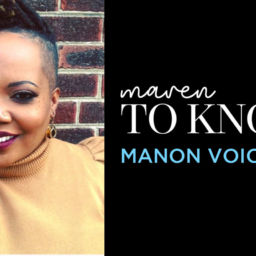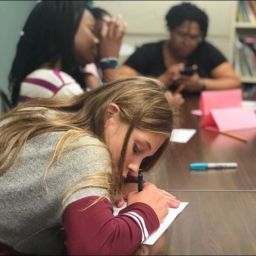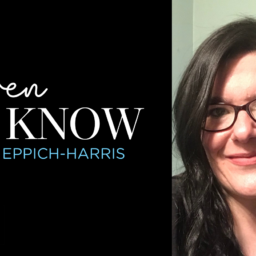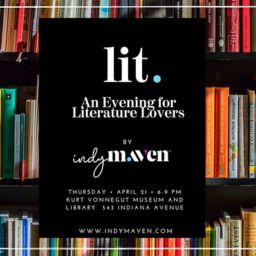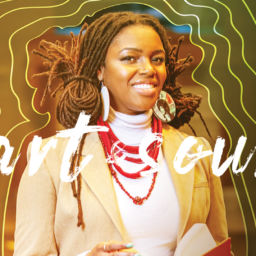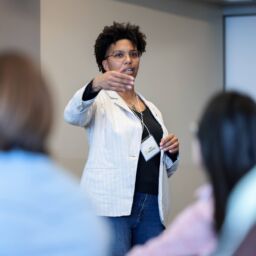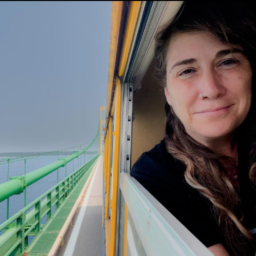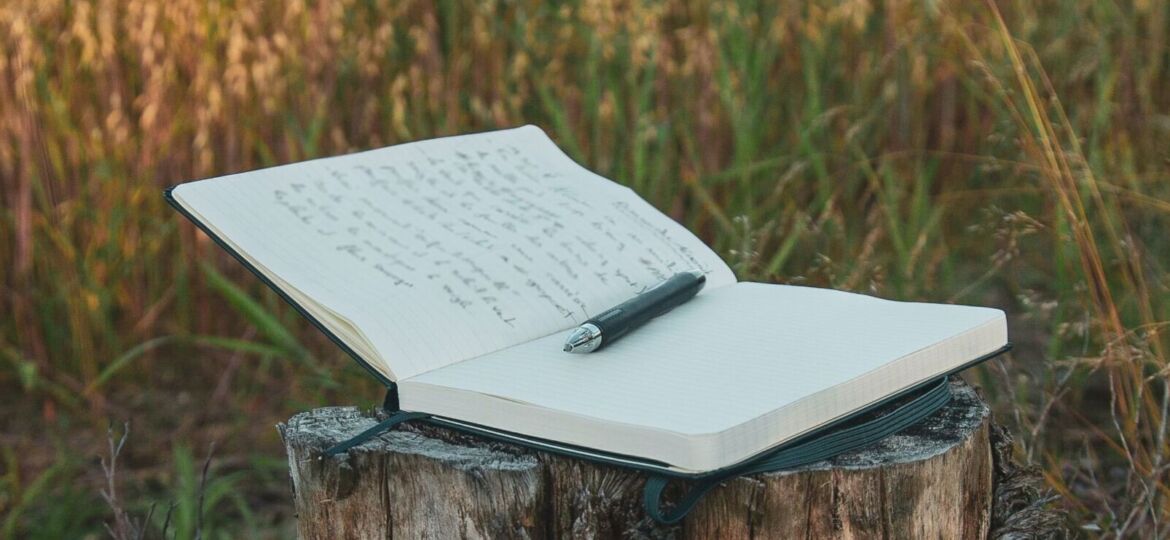
Poets play an important role in shaping culture, and that is no less true for the culture of Indianapolis.
National Poetry Month was launched by the Academy of American Poets in 1996. Observed every April as one of the largest literary celebrations in the world, National Poetry Month is an opportunity to recognize the importance of poetry and poets in our lives. Indianapolis is home to a thriving world of poets gracing audiences in open mics and slams, populating our bookstores and libraries, and teaching the artform in our classrooms and afterschool programs.
New to the poetry scene? We’ve got you covered with this list of some of Indy’s iconic poets.
JOYCE BRINKMAN
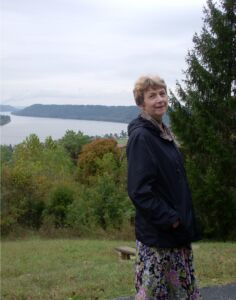 Joyce Brinkman, Indiana Poet Laureate 2002-2008, believes in poetry as public art. She creates public-poetry projects involving her poetry and the poetry of others. Her poetry is on permanent display in a twenty-five-foot stained glass window in an airport, in lighted glass artwork at a library, and on a wall in the town square of Quezaltepeque, El Salvador. Joyce has received fellowships from the Mary Anderson Center for the Arts, the Vermont Studio, and the Indianapolis Arts Council. Joyce is an author on several collaborative books and an anthology co-editor. She is a graduate of Hanover College and lives in Zionsville, Indiana, with a cantankerous cat. She is a founding board member of Brick Street Poetry Inc. and the producer of the poetry podcast “Off the Bricks.”
Joyce Brinkman, Indiana Poet Laureate 2002-2008, believes in poetry as public art. She creates public-poetry projects involving her poetry and the poetry of others. Her poetry is on permanent display in a twenty-five-foot stained glass window in an airport, in lighted glass artwork at a library, and on a wall in the town square of Quezaltepeque, El Salvador. Joyce has received fellowships from the Mary Anderson Center for the Arts, the Vermont Studio, and the Indianapolis Arts Council. Joyce is an author on several collaborative books and an anthology co-editor. She is a graduate of Hanover College and lives in Zionsville, Indiana, with a cantankerous cat. She is a founding board member of Brick Street Poetry Inc. and the producer of the poetry podcast “Off the Bricks.”
What was your first poem about?
A meadow.
Where is your favorite place to write?
A meadow.
If you could plant one of your poems as a seed, what would grow from it?
A meadow.
This is not to say that I haven’t grown in my choice of subject manner. Instead, it is a metaphor for the fact that I write about whatever springs up before me like the mixture that unfolds in a meadow.
Listen: Poetry at Noon: The Air Poets
MARIAH IVEY
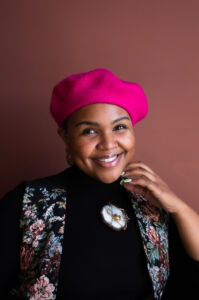 Mariah Ivey, recently muraled as a ‘Keeper of Culture’ by visual artist Ashley Nora x GangGang, is a nationally renowned poet, musician, scholar, and curator. While her love for the arts has landed her across national stages–including the ‘Art is Life’ east coast poetry tour as well as having opened for cultural icons like Beverly Bond, founder of Black Girls Rock–she’s found great passion behind the scenes for intentional space-making: curating accessible arts and cultural experiences for all. Mariah serves as the Programs & Outreach Manager for the iconic Madam Walker Legacy Center, Board Vice-President of the Naptown African American Theatre Collective, and founder and host of That Peace Open Mic, a local performing arts hub which exists to amplify the stories of Black and Brown artists.
Mariah Ivey, recently muraled as a ‘Keeper of Culture’ by visual artist Ashley Nora x GangGang, is a nationally renowned poet, musician, scholar, and curator. While her love for the arts has landed her across national stages–including the ‘Art is Life’ east coast poetry tour as well as having opened for cultural icons like Beverly Bond, founder of Black Girls Rock–she’s found great passion behind the scenes for intentional space-making: curating accessible arts and cultural experiences for all. Mariah serves as the Programs & Outreach Manager for the iconic Madam Walker Legacy Center, Board Vice-President of the Naptown African American Theatre Collective, and founder and host of That Peace Open Mic, a local performing arts hub which exists to amplify the stories of Black and Brown artists.
What was your first poem about?
My first poem actually doubled as a rap. I was about ten years old. The youngest of three and like most babies of the family, I felt as though my siblings were constantly ganging up on me. What better way to channel those emotions than to lean into art? As an outlet, I’d write extremely comical (but very very serious at that time) poems + raps about them and then I’d perform the pieces for them…just to take it a step further. Essentially, a 10-year-old diss track performed with remarkable confidence and clarity. This was and still is hilarious to our family. Not only were they somewhat responsible for my start, they truly are my biggest supporters and I love them dearly.
Where is your favorite place to write?
Most ideas come to me while driving. If I’m unable to write, I’ll usually voice memo a freestyle, concept, line, or melody while on the go. However, when I’m able to sit down and put pen to pad, I simply enjoy writing anywhere in my home.
If you could plant one of your poems as a seed, what would grow from it?
A beloved community—whose only purpose is to know love and spread love, abundantly.
Listen: Mariah Ivey and the Wug Laku Mental Health & Wellness Grant
Social Media: Instagram
KELSEY JOHNSON LYONS
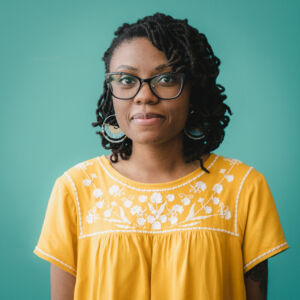 Kelsey Johnson Lyons is a poet, actor and educator. She has taught with the Indiana Writers Center through their Building A Rainbow and Poetry Out Loud programming, as a literacy coach with Indy Reads and as a classroom theater teacher on the Near East Side. Her poetry and other writing have appeared in The Wabash Review, A Feminist Thread, 805 Lit, Indy Maven, in collaboration with Summit Performance Indianapolis and on stage at Conner Prairie. When she’s not acting, writing or teaching she enjoys reading, singing spirituals in honor of her grandmother and getting lost in the woods.
Kelsey Johnson Lyons is a poet, actor and educator. She has taught with the Indiana Writers Center through their Building A Rainbow and Poetry Out Loud programming, as a literacy coach with Indy Reads and as a classroom theater teacher on the Near East Side. Her poetry and other writing have appeared in The Wabash Review, A Feminist Thread, 805 Lit, Indy Maven, in collaboration with Summit Performance Indianapolis and on stage at Conner Prairie. When she’s not acting, writing or teaching she enjoys reading, singing spirituals in honor of her grandmother and getting lost in the woods.
What was your first poem about?
I don’t remember the first poem I wrote. I remember being in the 5th grade and sharing my poem in front of the class. I remember writing a line about the stars above our heads. But I was so nervous sharing my poem that I spoke very softly and grabbed hold of my pant legs and kind of inched them up my legs, bit by bit.
Where is your favorite place to write?
My favorite place to write is in my study. The study is a work-in-progress, but it’s the place in our home where I feel the most creative. We have so many books! And art on the walls. And there’s a steady collection of household plants that are growing. It’s a nice place to sit and daydream.
If you could plant one of your poems as a seed, what would grow from it?
If I could plant my poems as seeds, my hope is that some truth would grow from them. I hope that when people hear or read my words, something would move within them, and they would be drawn into a deeper understanding of themselves, others and the world around them. I hope my poems lead people to ask more questions. One of the first poems I ever read was by Mary Oliver. In the poem, she asks the question, “What is it you plan to do with your one wild and precious life?” I read that question as a young artist and have been trying to answer it with my own art ever since.
Listen: From the Earth to the Stars
Social Media: Instagram
CHANTEL MASSEY
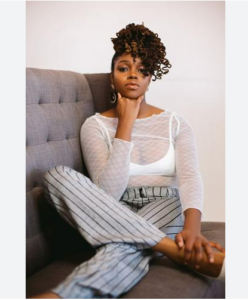 Chantel Massey is a storyteller, poet, author, teaching artist, editor, organizer, educator, practicing Afrofuturist and avid anime lover. Massey’s work advocates for wellness, human rights and social justice. Massey is a fellow of The Watering Hole, VONA poetry resident, and has received support from Brooklyn Poets, Hurston/Wright Foundation and Tin House. She is a 2023 Best of Net Award winner and 2020 Indiana Eugene and Marilyn Glick Author Awards Emerging Author finalist for her first collection of poetry, Bursting At The Seams (VK Press, 2018). Massey founded UnLearn Arts, a literary arts organization radically dedicated to amplifying and cultivating the craft and wellness of BIPOC writers in the Midwest and elsewhere. Her work can be found featured in Indianapolis Review, Turnpike Magazine and other online and print publications coming elsewhere.
Chantel Massey is a storyteller, poet, author, teaching artist, editor, organizer, educator, practicing Afrofuturist and avid anime lover. Massey’s work advocates for wellness, human rights and social justice. Massey is a fellow of The Watering Hole, VONA poetry resident, and has received support from Brooklyn Poets, Hurston/Wright Foundation and Tin House. She is a 2023 Best of Net Award winner and 2020 Indiana Eugene and Marilyn Glick Author Awards Emerging Author finalist for her first collection of poetry, Bursting At The Seams (VK Press, 2018). Massey founded UnLearn Arts, a literary arts organization radically dedicated to amplifying and cultivating the craft and wellness of BIPOC writers in the Midwest and elsewhere. Her work can be found featured in Indianapolis Review, Turnpike Magazine and other online and print publications coming elsewhere.
What was your first poem about?
The first poem I ever wrote was about my family. I was 8 years old, and I was learning about poetry. I come from a big family, and at the time we were all always together, so I wrote about them and how much I loved them.
Where is your favorite place to write?
My favorite place to write is in nature for the most part, or at home at my dinner table. Both places are very peaceful.
If you could plant one of your poems as a seed, what would grow from it?
I would plant my poem “Permission on Holy Ground,” my first attempt at a Black Joy poem. It would grow into a conversation on resistance, joy and hopefully questions around how to sustain that joy – who does one need to have delight in their lives and why?
Listen: “Black Sheep” and “Permission on Holy Ground” poems by Chantel Massey
EMILY PERSIC
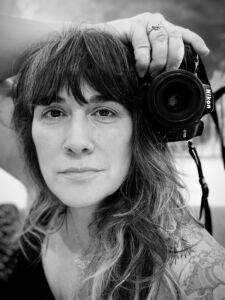 Emily has been known to characterize herself at unguarded moments as “stubborn, arrogant, smart, insecure, confident, curious, noisy and a middle child.” She has brown eyes, small wrists and believes she walks too fast, which she uses as an ineffective excuse for her clumsiness. This un-solitary life is formed by tragedy and beauty, love and anger, in equal doses. In this, Emily finds purpose: whether it is found in busy foreign streets, wild holy places or her own backyard, she stumbles across images and finds them irresistible. She strives everyday to see, really see; it seems so many images of grace and tragedy slip by without acknowledgment because the world is unwilling to open its eyes — not only to the obvious, but to the possible. While in a new place, all is strange and astounding and beautiful to her. When she returns home, things become clearer: the torn curtain, the dingy wall, the beautiful, overgrown garden, the people in the city walking down the street who turn toward or away from each other in hope and agony. Despite situations and visions of a nation, a world, that seem increasingly dark, Emily retains an absurd and steadfast sense of optimism.
Emily has been known to characterize herself at unguarded moments as “stubborn, arrogant, smart, insecure, confident, curious, noisy and a middle child.” She has brown eyes, small wrists and believes she walks too fast, which she uses as an ineffective excuse for her clumsiness. This un-solitary life is formed by tragedy and beauty, love and anger, in equal doses. In this, Emily finds purpose: whether it is found in busy foreign streets, wild holy places or her own backyard, she stumbles across images and finds them irresistible. She strives everyday to see, really see; it seems so many images of grace and tragedy slip by without acknowledgment because the world is unwilling to open its eyes — not only to the obvious, but to the possible. While in a new place, all is strange and astounding and beautiful to her. When she returns home, things become clearer: the torn curtain, the dingy wall, the beautiful, overgrown garden, the people in the city walking down the street who turn toward or away from each other in hope and agony. Despite situations and visions of a nation, a world, that seem increasingly dark, Emily retains an absurd and steadfast sense of optimism.
What was your first poem about?
The first poem I clearly remember writing and sharing with someone was in 3rd grade. It was- as is appropriate at that age- about a unicorn.
Where is your favorite place to write?
Almost always in my car. I have a bunch of kids, and I homeschool 3 of them. The car is often the one place I can really let my mind wander and formulate a plan. That said, the location I prefer to write has changed and will always change. I do most of my editing sitting on my bed.
If you could plant one of your poems as a seed, what would grow from it?
OOOF. That’s hard. A very tenacious vine that grows flowers–a trumpet vine comes to mind.
Read: A Poem for my mother on her 76th birthday
Social Media: Instagram
TATJANA REBELLE
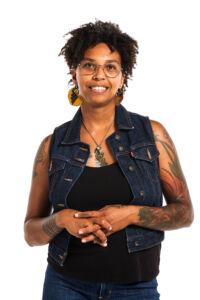 Tatjana Rebelle (they/them) has created a lasting career as a writer, events curator and spoken word artist, melding artistic expressions and activism. They have written for the Indianapolis Recorder and Indianapolis Monthly, facilitated a TEDxTalk and performed at the California African American Museum. Rebelle has contributed to several published works, including best selling author Tamara Winfrey Harris’s book Dear Black Girl: Letters From Your Sisters About Stepping Into Your Power. They have been a Wayfinder Fellow, Creative Renewal Fellow, assisted with co-founding several community centered coalitions and former Peacebuilding Intern with American Friends Service Committee. Currently Rebelle serves as the Director of Equitable Initiatives for Earth Charter Indiana and a member of the Looking Glass Alliance, the creatives group working with Newfields to look at American art in new ways.
Tatjana Rebelle (they/them) has created a lasting career as a writer, events curator and spoken word artist, melding artistic expressions and activism. They have written for the Indianapolis Recorder and Indianapolis Monthly, facilitated a TEDxTalk and performed at the California African American Museum. Rebelle has contributed to several published works, including best selling author Tamara Winfrey Harris’s book Dear Black Girl: Letters From Your Sisters About Stepping Into Your Power. They have been a Wayfinder Fellow, Creative Renewal Fellow, assisted with co-founding several community centered coalitions and former Peacebuilding Intern with American Friends Service Committee. Currently Rebelle serves as the Director of Equitable Initiatives for Earth Charter Indiana and a member of the Looking Glass Alliance, the creatives group working with Newfields to look at American art in new ways.
What was your first poem about?
I wrote my first poem in middle school and still perform it to this day when I feature. It was about being in an abusive household and how that impacted me.
Where is your favorite place to write?
I perform to write poetry outside of my home. Bars. Libraries. Public parks. Any place where I can get lost in a moment and have the chance to observe people. It’s my greatest inspiration.
If you could plant one of your poems as a seed, what would grow from it?
The Treasured to date is the most important piece I’ve written. I want it to inspire the youth to remember their power and know they are worthy of the life of joy. Empowerment is what I hope comes from my work.
Listen: The Treasured
MANÒN VOICE
 Manòn Voice is a poet, writer, spoken word artist, filmmaker, actor, hip-hop emcee, educator and community builder. The spirit of her work finds its niche at the intersection of arts and activism. She has performed on diverse stages across the country in the power of the word and has taught and facilitated writing and poetry workshops widely. Her poetry has appeared in The Flying Island, The Indianapolis Review, The House Life Project: People + Property Series, Sidepiece Magazine, The World We Live(d) In Anthology, The Indianapolis Anthology, Questions for a Resilient Future, and Kinship: A World of Relations. She has been featured in publications such as Indy NUVO, The Indianapolis Recorder, Indianapolis Monthly, The Indianapolis Star, FAFCollective, Pattern Magazine, Sidepiece Magazine, and more. In 2018, Manòn received a nomination for the Pushcart Prize in Poetry.
Manòn Voice is a poet, writer, spoken word artist, filmmaker, actor, hip-hop emcee, educator and community builder. The spirit of her work finds its niche at the intersection of arts and activism. She has performed on diverse stages across the country in the power of the word and has taught and facilitated writing and poetry workshops widely. Her poetry has appeared in The Flying Island, The Indianapolis Review, The House Life Project: People + Property Series, Sidepiece Magazine, The World We Live(d) In Anthology, The Indianapolis Anthology, Questions for a Resilient Future, and Kinship: A World of Relations. She has been featured in publications such as Indy NUVO, The Indianapolis Recorder, Indianapolis Monthly, The Indianapolis Star, FAFCollective, Pattern Magazine, Sidepiece Magazine, and more. In 2018, Manòn received a nomination for the Pushcart Prize in Poetry.
What was your first poem about?
My first poem was entitled “Life Goes On” and was about an unrequited crush. Hilariously, I was probably in third grade.
Where is your favorite place to write?
My favorite writing place is in the natural world, besides the water. I love the ocean, and it’s a consistent muse of poetic inspiration.
If you could plant one of your poems as a seed, what would grow from it?
If I could plant my poems as seeds, they would grow as witnesses and testifiers of truth, beauty and the human struggle for meaning-making and wholeness.
Listen: Feast Table of Our Future
Social Media: Website
CHARLOTTE YEUNG
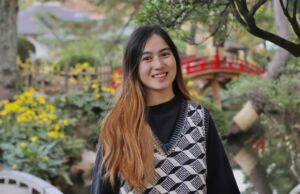 Charlotte Yeung is the 2023 Midwest Ambassador, 2023 Frederick Douglass Global Fellow, and 2022 Indy Youth Poet Laureate. She is the first Hongkongese American who is a National Youth Poet Laureate finalist and the first Asian American Midwest ambassador.* Her children’s book Isabelle and the Magic Bird was an Amazon #1 New Release. Charlotte has a strong interest in international relations and using writing to facilitate intercultural ties. She is the founder and lead instructor for a poetry workshop series for women in Afghanistan. Her award-winning art and writing is published on multiple platforms from the New York Times to Carnegie Hall. Her first multilingual poem will be sent to the Moon in 2024 as part of the Lunar Codex.
Charlotte Yeung is the 2023 Midwest Ambassador, 2023 Frederick Douglass Global Fellow, and 2022 Indy Youth Poet Laureate. She is the first Hongkongese American who is a National Youth Poet Laureate finalist and the first Asian American Midwest ambassador.* Her children’s book Isabelle and the Magic Bird was an Amazon #1 New Release. Charlotte has a strong interest in international relations and using writing to facilitate intercultural ties. She is the founder and lead instructor for a poetry workshop series for women in Afghanistan. Her award-winning art and writing is published on multiple platforms from the New York Times to Carnegie Hall. Her first multilingual poem will be sent to the Moon in 2024 as part of the Lunar Codex.
*The National Youth Poet Laureate program is a program of Urban Word, and the Indianapolis Youth Poet Laureate program is its affiliate and led by VOICES.
What was your first poem about?
The first poem that I wrote for fun was about climate change and the future. It started off describing the beauty of a sparrow flying amongst trees and blue skies. Then the tone shifts and the narrator reveals that they have never seen such a thing, that they are looking at a drawing sitting in a crushed frame. I think this poem combines many of my interests—climate change, social issues, sci-fi and environmentalism.
Where is your favorite place to write?
I will write anywhere. My favorite place to write is in the woods by myself. I have this slightly irrational fear that someone will look over my shoulder and look at what I’m writing when I’m in a café or library. The best time to write is when it’s a crisp autumn, cool and late enough that the leaves carpet the forest floor and crunch when someone steps on them. I feel like I’m a character in the poems or stories I write when I’m in a forest.
If you could plant one of your poems as a seed, what would grow from it?
“Seeds of Peace,” one of my poems, is a memorial to the hibakusha, survivors of the nuclear bomb. I hope that those who read it feel a desire to change things sprout in them. The poem goes over the experiences and perspectives of Yoshiko Kajimoto, Soh Horie and Koko Kondo. The deep, decades-long impact of the nuclear bomb can be felt in their stories. I hope that those who read that poem will support and advocate for a future free of nuclear weapons and hope for a more peaceful world.
Listen: Purdue Student is National Youth Poet Laureate Finalist
JANUARIE YORK
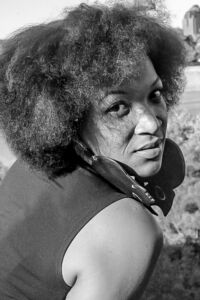 Januarie York is a freelance writer, published author, poet, and the Center for Black Literature and Culture’s first Poet Laureate. In addition to performing original works of poetry, she has produced several of her own spoken-word theatrical shows that focus on uplifting and inspiring women. Januarie has released two spoken word albums and one chapbook of poetry, and she runs an online magazine publication called, “LiT Magazine.” She has also acted in several plays including “For Colored Girls Only,” for which she wrote two original works. Her first full-length book, nomaD, was released in June 2022, along with its immediate follow up, “No Man’s Land.” Recently, Januarie wrote the opening poem for the nationally recognized Major Taylor exhibit at the Indiana State Museum.
Januarie York is a freelance writer, published author, poet, and the Center for Black Literature and Culture’s first Poet Laureate. In addition to performing original works of poetry, she has produced several of her own spoken-word theatrical shows that focus on uplifting and inspiring women. Januarie has released two spoken word albums and one chapbook of poetry, and she runs an online magazine publication called, “LiT Magazine.” She has also acted in several plays including “For Colored Girls Only,” for which she wrote two original works. Her first full-length book, nomaD, was released in June 2022, along with its immediate follow up, “No Man’s Land.” Recently, Januarie wrote the opening poem for the nationally recognized Major Taylor exhibit at the Indiana State Museum.
What was your first poem about?
My first poem was about death; at the time, I had lost my 17 year old stepbrother, a neighbor, and a childhood friend to gun violence, and it was all around me even when I didn’t know the people. I still felt something. So the first poem I wrote about was about the death of my stepbrother, neighbor, and childhood friend, with each one having a stanza dedicated to them, and the final one being the ‘whole’ of the poem. I think each stanza was about four lines. It was handwritten in cursive, black ink, and I remember that because the ink started to blur on a couple of different parts. My mom probably still has this poem stashed somewhere.
Where is your favorite place to write?
My favorite place to write is at home in my bed. I like to turn on my tv, and honestly, sometimes my phone as well (yes, at the same time!), and just start writing. Because of my schedule, I don’t often get to just sit down and write with the intention of spending the next X-amount of time writing, but whenever I feel a writing spurt, I try to respond to it. Usually that’s when I’m in my most relaxed stage, or especially watching or listening to something because I hear lines in the things that people say. But sitting back in my bed, surrounded by pillows and a good tv show (probably a crime documentary) is where I feel my most relaxed writing stage. Something I do want to try in the near future is renting a hotel room for the purpose of writing and changing my writing scenery. That’s something that Maya Angelou was known for doing, and I think I would enjoy adding that to my regular routine if possible, even if it’s just a monthly or quarterly thing that I do. Rent a really nice room, order room service, get a massage if they offer one, have a glass of wine and sit down to write – that is something I have yet to do but is on my next 90 days list, and I imagine it will instantly become one of my favorites.
If you could plant one of your poems as a seed, what would grow from it?
Love would grow – it’s the space that I write from and what I seek when I write. Love is all things, yet so greatly missing or easily discontinued. I would say my poems are seeds of love that I put into the universe and hope will make others feel loved on, even by strangers or through the medium of a poem. It might sound silly or superficial or even cliché, but I’ve always been obsessed with love – having it, creating it, being around it and curating environments that reiterate it. Love is in every poem because they all originate from my heart and from an emotional space of needing, desiring or pushing love. So rightfully, the first and best thing that could grow from my poems would be abundant love, especially in this society where it is easily becoming thinly veiled and covered up. My poems would allow gardens of love to burst through the cracks and crevices of this thing we call life and reach the people who need it and yearn for it the most.
Brandi Metzger is a writer, teaching artist, and production assistant. Find her on LinkedIn and WordPress.
All of our content—including this article—is completely free. However, we’d love it if you would please consider supporting our journalism with an Indy Maven membership.


